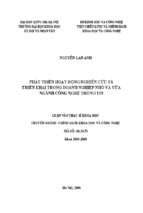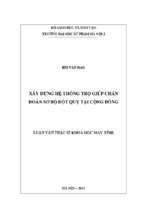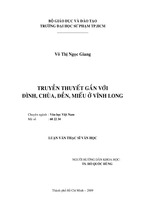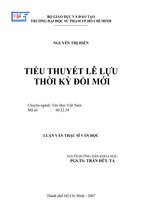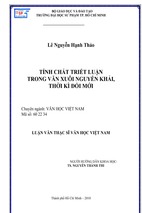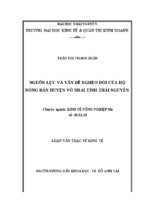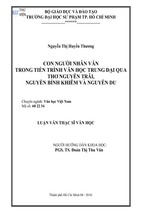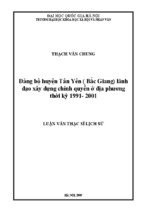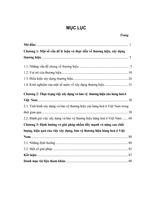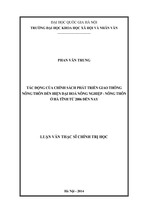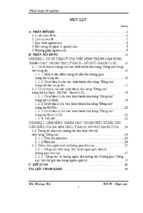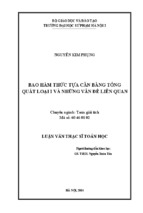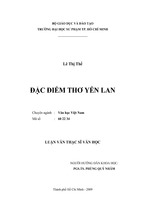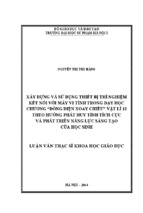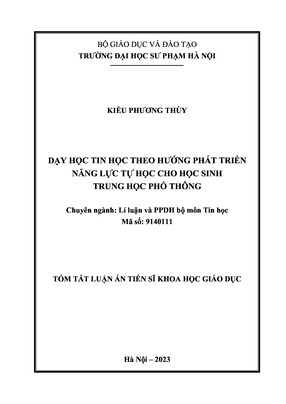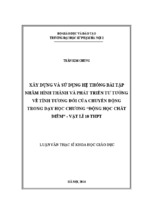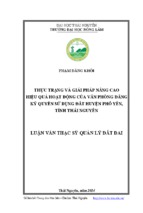The values of individualism and collectivism have been proved to exert profound effects on many aspects of life respectively in America and Vietnam, among which is the two groups of people’s verbal communication styles. However, it seems that this interesting topic has yet to be widely explored. By employing the questionnaires to collect data from 40 European American and Vietnamese informants, the study demonstrates their understandings of the dominant value in their society, as well as how it is reflected in their language use in terms of directness or indirectness, formality or informality. The result confirms the exploitation of directness in American conversations as a manifestation of individualism. Nevertheless, it also re-questions the popular remark that indirectness and formality – signs of collectivism are preferred by Vietnamese interlocutors and the same as European American ones with informality – sign of individualism, as the dependence is on specific situations. Finally, some cross-cultural recommendations are given with the hope to enhance mutual understandings between two groups of people when they communicate with one another
VIETNAM NATIONAL UNIVERSITY, HANOI
UNIVERSITY OF LANGUAGES AND INTERNATIONAL STUDIES
THE FALCULTY OF ENGLISH LANGUAGE TEACHER EDUCATION
GRADUATION PAPER
THE REFLECTIONS OF INDIVIDUALISM AND
COLLECTIVISM ON VERBAL COMMUNICATION
STYLES IN AMERICAN ENGLISH AND
VIETNAMESE
Supervisor: Do Thi Mai Thanh (M.A.)
Student: Nguyen Thi Ngoc Diep
QH2008.F1.E1
SUBMITTED IN PARTIAL FULFILLMENT OF THE REQUIREMENTS
FOR THE DEGREE OF BACHELOR OF ARTS (TEFL)
Hanoi - 2012
ACCEPTANCE
I hereby state that I: Nguyen Thi Ngoc Diep, 081.E1, being a candidate for the degree
of Bachelor of Arts (TEFL) accept the requirements of the College relating to the retention
and use of Bachelor’s Graduation Paper deposited in the library.
In terms of these conditions, I agree that the origin of my paper deposited in the library
should be accessible for the purposes of study and research, in accordance with the normal
conditions established by the librarian for the care, loan or reproduction of the paper.
Signature
May 2nd, 2012
i
ACKNOWLEDGEMENTS
First of all, on the completion of the study, I would like to express my
deepest gratitude to my supervisor, Ms. Do Thi Mai Thanh for her immeasurable
help, constant guidance and support during all stages of the study and beyond,
from whom I have received valuable suggestions and careful critical comments.
Second, I would like to send my heartfelt thanks to my two special friends
Ashley Parker and Hoang Minh Trang, who have enthusiastically helped me in
the data collection process – a decisive factor for the success of this study.
I also owe a great debt of gratitude to my parents, my sister and my
friends, particularly the whole 08.1.E1, who have constantly encouraged me and
supported me wholeheartedly during the time of conducting the research.
Last but not least, I would like to thank the readers who share their interest
and feedback on the study.
ii
ABSTRACT
The values of individualism and collectivism have been proved to exert
profound effects on many aspects of life respectively in America and Vietnam, among
which is the two groups of people’s verbal communication styles. However, it seems
that this interesting topic has yet to be widely explored.
By employing the questionnaires to collect data from 40 European American
and Vietnamese informants, the study demonstrates their understandings of the
dominant value in their society, as well as how it is reflected in their language use in
terms of directness or indirectness, formality or informality. The result confirms the
exploitation of directness in American conversations as a manifestation of
individualism. Nevertheless, it also re-questions the popular remark that indirectness
and formality – signs of collectivism are preferred by Vietnamese interlocutors and the
same as European American ones with informality – sign of individualism, as the
dependence is on specific situations. Finally, some cross-cultural recommendations are
given with the hope to enhance mutual understandings between two groups of people
when they communicate with one another.
iii
TABLE OF CONTENT
ACKNOWLEDGEMENTS............................................................................................i
ABSTRACT……………………………………………………………………………ii
TABLE OF CONTENT……………………………………………………………....iii
LIST OF FIGURES…………………………………………………………………..vi
LIST OF TABLES………………………………………………………………...…vii
LIST OF ABBREVIATIONS…………………………………………………...….viii
CHAPTER 1: INTRODUCTION…………………………………………………….1
1. Statement of the research problem and rationale…………………………................1
2. Research questions…………………………………………………………………..2
3. Scope of the study…………………………………………………………………...2
4. Significance of the study…………………………………….……………………...3
5. Research methodology………………………………………………………...…….4
5.1.
Data collection method and procedures…………………………….……4
5.2.
Data analysis methods and procedures……………………………….….4
6. Organization of the paper…………………………………………………….………4
CHAPTER 2: THEORETICAL BACKGROUND………………………………….6
1. Language and culture………………………………………………………….…….6
2. The concepts of individualism and collectivism……………………………………6
2.1.
Individualism and collectivism in history….…………………………….6
2.2.
Individualism and collectivism in the paper……………….…………….8
2.3.
Interpretations of individualism and collectivism from the perspectives of
American and Vietnamese cultures and languages…………………………………10
2.3.1.
Individualism in American culture and language……….……………...10
2.3.2.
Collectivism in Vietnamese culture and language………….…………..13
2.3.3.
Some reasons to explain the values of individualism and collectivism in
American and Vietnamese cultures and languages………………………….……15
iv
3. Some manifestations of the reflections of individualism and collectivism in
American and Vietnamese verbal communication styles……………..……….……...16
3.1.
Direct and indirect verbal communication styles……………...…….….16
3.1.1.
Low context and high context communication…………………………16
3.1.2.
Directness and indirectness………………………………………….….17
3.2. Informal and formal communication styles……………………………..……..19
4. Speech acts of request, complement and complaint…………………….…………..21
4.1.
Requesting………………………………………………………………21
4.2.
Complementing……………………………………………………..…..21
4.3.
Complaining……………………………………………………….……22
5. Summary of previous studies……………………………………………………….22
CHAPTER 3: METHODOLOGY…….…………………………………………….23
1. Research design……………………………………………………………………..23
2. Data collection method……………………………………………………….….....23
3. Discussion of the survey questionnaire content…………………………………….24
4. Informants and data collection procedures………………………………….……...25
5. Data analysis methods and procedures…………………………………….…….…26
CHAPTER 4: FINDINGS AND DISCUSSION…………………………...……….27
1. The concepts of individualism and collectivism……………………………….…...27
2. Manifestation of individualism and collectivism in verbal communication
styles……………………………………………………………………………...…31
2.1.
2.1.1.
Directness and indirectness………………………………...…………...31
In the English survey questionnaire…………………...………………..31
2.1.1.1. In requesting……………………………………………………….……31
2.1.1.2. In complimenting………………………………………………...……..32
2.1.1.3. In complaining………………………………………………...………..32
2.1.2.
In the Vietnamese questionnaire……………………….……………….33
2.1.2.1. In requesting………………………………..……….……………….….33
v
2.1.2.2. In complimenting……………………….………………………..….….33
2.1.2.3. In complaining………………………….………………………..….….33
2.1.3.
2.2.
2.2.1.
Similarities and differences……………………………………….…….34
Informality and formality………………………………………….........35
In the English survey questionnaire…………..…………………….…..35
2.2.1.1. In requesting…………………………………………………...…….….35
2.2.1.2. In complimenting……………………………………….…..……….….36
2.2.1.3. In complaining……………………………………….……..…………..36
2.2.2.
In the Vietnamese survey questionnaire……………....…………….….36
2.2.2.1. In requesting……………………………………….………..…….……36
2.2.2.2. In complimenting………………………………….……….…….….….37
2.2.2.3. In complaining…………………………………….……….…….….….37
2.2.3.
Similarities and differences………………………...…………….…….38
CHAPTER 5: CONCLUSION………………………………………………..….…39
1. Summary of the findings and concluding remarks…………………….………..….39
2. Recommendations for cross-cultural communication……………….……………..39
2.1. Directness and indirectness in American English and Vietnamese….…….…..39
2.2. Formality and informality in American English and Vietnamese…….……….40
3. Limitations of the study…………………………………………………………….40
4. Suggestions for further study……………………………………………………….41
REFERENCE LIST…………………………………………………………….…....42
APPENDICE…………………………………………………………………………46
Questionnaire (English version)…………………………….………………….…..….46
Questionnaire (Vietnamese version)…………………………….……………….……48
vi
LIST OF FIGURES
Figure
Page
Figure 1: Percentage of dominant value in America………………………….…..…..27
Figure 2: Defined characteristics of individualism in American culture……….….…28
Figure 3: Percentage of dominant value in Vietnam………………………………….29
Figure 4: Defined characteristics of collectivism in Vietnamese culture………….…30
vii
LIST OF TABLES
Table
Page
Table 1: Individualism and collectivism over the years (adapted and rearranged from
Kagitcibasi et. al 1997)…………………………………………………………………8
Table 2: Summary of directness/indirectness in American English and Vietnamese...34
Table 3: Summary of formality/informality in American English and Vietnamese….38
viii
LIST OF ABBREVIATIONS
C: Collectivism
D: Directness
DCT: Discourse completion task
EFL: English as a foreign language
F: Formality
I: Individualism
ID: Indirectness
IF: Informality
ix
x
CHAPTER 1: INTRODUCTION
This initial chapter outlines the research problem and rationale for the study
together with its methodology, the scope and the significance of the paper.
Particularly, it is in this chapter that two research questions are identified to serve as
guidelines for the whole study. Finally, the chapter concludes with a sketch of the
organization of the paper to orientate the readers throughout the paper.
1.
Statement of the research problem and rationale
It is well established that Hofstede’s (1983) pioneering research which mapped
53 countries on four cultural dimensions (power distance, individualism-collectivism,
masculinity-femininity and uncertainty avoidance) has “inspired a great deal of
research on related fields” (Singer & Voronov 2002, p. 461). The dimension of
individualism-collectivism has become, as some scholars fear, a “catchall default
explanation for cultural differences in human behavior” (Kagitcibasi 1997, p. 3).
Indeed, the constructs of individualism and collectivism were largely responsible for
the explosion of cross-cultural psychology over the past three decades and continued to
be theoretically and empirically the most prominent constructs in cross-cultural
psychology in the 1990s (Kashima et al. 1995, p. 925). Triandis (1988, p. 60) even
regarded individualism-collectivism as “the most important dimension of cultural
differences in social behavior”. What is more, Vandello and Cohen (1999, p. 279)
concurred that “one of the most useful and actively researched constructs to emerge
from cultural social psychology has been the dimension of individualism-collectivism”.
In Vietnam, the economic open-door policy pursued by the Government has
increased the demand for English-speaking people who are expected to acquire both
linguistic competence and sociocultural one to access the outside world, as it is
acknowledgeable about the significant interrelation between language and culture that
“to know another’s language and not his culture is a very good way to make a fluent
1
fool of one’s self” (cited in Nguyen n.d, p. 38). Nonetheless, no matter how growing
and special the need for cross-cultural/ intercultural communication is, the sad fact is
there are only a small number of Vietnamese EFL (English as a foreign language)
speakers who have a good command of cultural awareness and understandings,
accompanied by the target language. With the hope of contributing to a better
understanding of American culture whose individualistic index ranks the first
(Hofstede 1980) and Vietnam – a prominently collectivistic society, as well as their
deep reflections on verbal communication styles in the two languages, the researcher
attempted to investigate into the topic “The reflections of individualism and
collectivism on verbal communication styles in American English and Vietnamese”.
2.
Research questions
The study was done with an aim to answering the two following questions:
(1)
To what extent are the values of individualism and collectivism
understood by American and Vietnamese people?
(2)
How are the values of individualism and collectivism reflected in verbal
communication styles in American and Vietnamese cultures?
3.
Scope of the study
Firstly, the values of individualism and collectivism have wide effects on many
aspects of life. In this study, however, the focuses are just on their influences on verbal
language use in the light of directness and indirectness, informality and formality in
American English and Vietnamese.
Secondly, language carries with it a broad realm of reflection, thus in this paper,
the author attempts to investigate the manifestation of the dimension individualismcollectivism via three communicative acts, which happen popularly in the people’s
daily lives. They are requesting, complaining and complimenting. In other words, the
2
purpose is to find out how the speakers in each country response in supposedly
interactive situations in terms of directness and indirectness, informality and formality.
Thirdly, there are many groups of Americans coming from different parts of the
world as America has been a nation of immigrants for a long time. However, the
research only pays attention to the Americans who have their origins in Europe in order
to ensure the nativeness and representativeness of the findings.
Lastly, due to the limited time and resources, the samples of the study were
restricted to 20 European Americans in selected city areas in the United States and 20
Vietnamese people living in the city of Hanoi, all of whom are students from the age of
20 to 24. This choice of samples helps ensure the homogeneity in their contexts of
living and mature thoughts in the answers, thus, generates comparable findings.
4.
Significance of the study
This research would be of benefits for a number of European Americans in
America and EFL speakers in Vietnam, as well as the researchers who are interested in
the same field.
In detail, the researcher hopes that by understanding the natures of direct –
indirect and informal – formal communication styles as seen from the values of
individualism and collectivism, Vietnamese EFL speakers will better their performance
when communicating with European Americans and vice versa. Cross-cultural/
intercultural communication breakdowns, therefore, would be reduced to the least.
Besides, with regards to researchers who share the same interest in the topic,
they could rely on this paper to find reliable and helpful information to develop their
related studies in the future.
3
5.
Research methodology
5.1.
Data collection methods and procedures
Questionnaires in form of Discourse Completion Tasks (DCT) were employed
during the process of data collection. Specifically, there were two language versions of
the questionnaires, one in English and the other in Vietnamese. The English
questionnaires were delivered to the informants in selected city areas including Boston,
San Francisco, Stockton in California and Maryville, Kansas in Missouri, USA
whereas the Vietnamese questionnaires were for the ones living in the city of Hanoi, all
of whom are students from the age of 20 to 24. Twenty questionnaires with answers
from each country were then chosen to the data analysis process.
5.2.
Data analysis methods and procedures
The information collected from two language versions of questionnaires, was
transcribed as the primary source of data for the research. Relevant sections were
identified or underlined during the evaluation of each piece of data. The contents were
to be sorted into categories based on the two research questions.
6.
Organization of the paper
The rest of the paper includes the following chapters:
Chapter 2 (Theoretical background) provides the theoretical background of the
study, including discussions of the key concepts and summary of previous studies.
Chapter 3 (Methodology) describes the research setting, participants, the
instrument of data collection as well as the procedure employed to carry out data
analysis.
4
Chapter 4 (Findings and discussion) presents, analyzes and discusses the results
that the researcher found out from the collected data according to the two research
questions.
Chapter 5 (Conclusion) summarizes the answers to the two research questions,
several cross-cultural communication recommendations concerning the research topic,
the limitations of the research as well as some suggestions for further studies.
Following this chapter are the References and Appendices.
5
CHAPTER 2: THEORETICAL BACKGROUND
This second chapter sheds light on key concepts in the study. Afterwards, a brief
review of the related studies will reveal the research gaps and hence lays the concrete
foundation for this research paper.
1.
Language and culture
According to Longman learner’s dictionary (2005), language is “a system of
sounds, words, patterns, etc. used by humans to communicate thoughts and feelings”.
Indeed, it is “used to give factual information, supply the information about the
speaker’s feelings or serve to establish and maintain social relations between people”.
(Dao & Do 2005, p. 7). From those views, it can be seen that language and culture are
interwoven in such a way that culture affects expressions of language and language is
filled with cultural factors.
2.
The concepts of individualism and collectivism
2.1. Individualism and collectivism in history
In the Handbook of cross-cultural psychology: Vol 3. Social behavior and
applications, p. 6, Kagitcibasi et. al exhibited a collection of definitions on
individualism and collectivism over the years, which was adapted and chronologically
rearranged as follows:
Individualism
Hsu (1983)
Collectivism
Self reliance, competitiveness; Low emotionality; seeking
aggressive
creativity; group
protection;
not
conformity; insecurity; large interested in competition; low
military spending; prejudice in creativity.
toward different racial and
6
religious groups; unrealistic
interpersonal
Triandis
Individual
is
an
end
in Emphasis on (a) the views,
(1990)
(after himself, and such ought to needs, and goals of the
Gould
& realize his “self” and cultivate (in)group; (b) social norms
Kolb, 1964)
his
own
judgement, and duty defined by the group
notwithstanding
social rather than pleasure seeking;
pressures toward conformity.
(c) beliefs shared with the
groups rather than beliefs that
separate self from group; and
(d) readiness to cooperate
with the group.
Janzx (1991)
Human
beings
as
the Emphasis on the group or
fundamental “building block” community; the group as the
of society “dignity,” of the source of value; the interests
individual; individual as the of
primary
source
(ethical
group
value precedence over those of the
goals
with
subsumed “commitment” as the moral
personal
ones; aspect of ideology; individual
individual
having
firm not separate from others, but
boundaries;
“equality”
of inextricably linked with them
individuals
(at
in or
least
embedded
in
principle); and “liberty” from individual
interference of others.
Ho & Chiu Value
(1994)
taking
individualism); individual,
collective
under
of
the
of
autonomy;
responsibility
group;
freedom
“restricted” by the group.
individual; Value
of
individual conformity;
the
group;
collective
(consequences responsibility (consequences
7
of
action
individual);
achievement;
affect
the of action affect the whole
individual group); group achievement;
self-reliance interdependence
(group
(individual interests; security interests; security in group
in individual’s strength).
solidarity).
Table 1: Individualism and collectivism over the years (adapted and rearranged
from Kagitcibasi et. al 1997)
From the above synthesis, it could be seen that there existed some developments
in terms of the understandings of the two concepts in history. First was Hsu’s which
showed some negative ideas about individualism and collectivism such as “prejudice
toward different racial and religious groups” for the former or “low emotionality” for
the latter. This researcher, however, also shared some similarities with the others about
the self in individualistic cultures and the spirit of groups in collectivistic ones. Later,
Triandis (1990), Ho & Chiu (1994) seemed to support relatively the same descriptions
of the two values, mostly about individuals standing on their own (individualism) and
responsibilities towards the groups (collectivism). Prominently, Janzx (1991) gave
some additions to what are termed individualism and collectivism, respectively were
“building block of society dignity, equality, liberty” and group “commitment as the
moral aspect of ideology, individual freedom restricted by the group”.
2.2. Individualism and collectivism in the paper
In this paper, the definitions of individualism and collectivism given by
Hofstede (1991) were employed. According to him, “Individualism stands for a society
in which the ties between individuals are loose; everyone is expected to look after
himself or herself and his or her immediate family only,” and “collectivism stands for a
society in which people from birth onwards are integrated into strong, cohesive
ingroups, which throughout people’s lifetime continue to protect them in exchange for
8
unquestioning loyalty” (p. 260-261). These characterizations involve both interpersonal
and normative aspects of individualism and collectivism.
In an individualistic society, emphasis is put on the goals and accomplishments
of the individual. When conflicts arise over the benefits, one tends to set priority to
his/her own purposes instead of other members’ in the community (Singelis et al
1995). In addition, independence from family as well as social and religious
organizations is commonly recognized; thus, privacy and the “self” are emphasized
(Triandis 1995). As a matter of fact, all the decisions are made from personal
perspectives and for individual sake without any concern about the groups. Personal
values include personal time, freedom, and challenge (Würtz 2005).
On the contrary, collectivistic cultures where solidarity, responsibility and
mutual help among members are always highly recommended prioritize group welfare
over the goals of the individual. The family's history often has an influence on the way
people see an individual whereas personal accomplishments play a minor role. When
the “we” outweigh the “I”, individuals in collectivistic cultures tend to be
interdependent with others and will usually have built a network of deep-rooted
relationships and personal, loyal ties (Triandis 1995). Lustig and Koetes (2010) also
shared the same opinion that in collectivistic cultures, groups are considered people’s
extended families and require them absolute loyalty. Besides, people appear to have
“in-group egoism” (Hofstede 1994) that they try to protect the benefits of their own
group’s members rather than those of other groups. Values in collectivistic cultures
include training, physical condition, and the use of skills (Würtz 2005).
According to Singelis et al (1995), Western modern industrial societies such as
America or Canada encourage individualism whereas Asian countries, Latin America
and Africa with tradition agricultural cultures prefer collectivism.
9
- Xem thêm -

